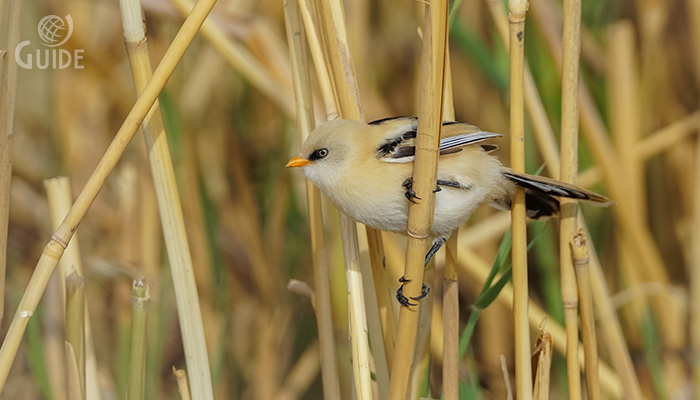
English: Bearded Parrotbill,
Bearded Tit, Bearded Reedling
Russian: Усатая синица
Mongolian: Сахал шагшуургабялзуухай, Сахалт хөх бух
German: Bartmeise
French: Panure
a moustaches
Japanese: ヒゲガラ (Higegara)
Body
length:
14-15½ cm.
The Bearded Reedling is (rather surprisingly) most closely related
to the larks, but is shown here due to its superficial similarity to the tits.
Breeds colonially in large reedbeds at lowland lakes and swamp margins. Very
local in Britain, almost entire population confined to E and S coasts of
England. Mainly resident, but dispersive, undertakes sporadic eruptions in
autumn (signaled by high ‘towering flights’ over breeding lake in dense, highly
excited flocks), some at least reaching more southerly winter grounds. Numbers
may be severely reduced by cold winters. Feeds on insects and reed seeds. Nest
of reed stems low in reeds.
Identification: A small, light
yellowish-brown bird with long pale yellow-brown tail glimpsed among the dense
jungle of reeds should always be a Bearded Reedling. Flight a little unsteady,
with irregular, shallow undulations and whirring wingbeats, almost as it
billowing forwards. Climbs reed stems nimbly. Often twitches tail or raises and
fans it. Occasionally spreads tail in flight, too.
- Adult ♂: Head light
blue-grey with long, black drooping moustache (in other words, despite name,
does not have beard!). Throat white. Undertail-coverts black.
- Adult ♀: Head
buffish-brown without black moustache. Throat off-white. Undertail-coverts
buff.
- Juvenile: Like adult ♀, but has black back and black areas on tail, and
plumage is a bit more yellowish-buff. ♂ separated from ♀ by all-black lores and
orange-yellow bill (♀: greyish or brown lores and grey-brown to greyish-black bill).
Moults to adult appearance Jul-Oct.